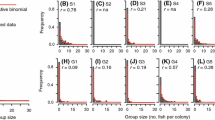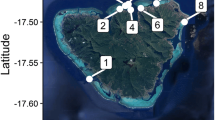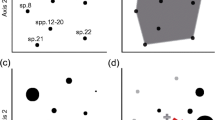Abstract
Both habitat preferences and social organization can influence the spatial distributions of individuals. We explored effects of individual behavior and social organization on distributions of arc-eye hawkfish (Paracirrhites arcatus) in lagoons of French Polynesia. Analysis of habitat selectivity data obtained during surveys revealed that the most highly preferred microhabitat of arc-eye hawkfish was large Pocillopora coral with an open branching morphology. However, such corals were rare and most hawkfish occupied smaller, less preferred Pocillopora. Indeed, total abundance of Pocillopora explained nearly two thirds of the lagoon-wide variation in abundance of hawkfish and the derived relationship between the numbers of hawkfish and Pocillopora predicted 86% of the spatial variation in hawkfish abundance during subsequent surveys. In contrast, large, open-branched Pocillopora explained little of the spatial variation in abundance of hawkfish. Individual behavior and social organization significantly impacted use of the most highly preferred Pocillopora. During a colonization experiment set up outside hawkfish home ranges, all colonizers resided on the most highly preferred corals. Following addition of the most highly preferred Pocillopora corals to areas occupied by hawkfish, only the largest, socially dominant individuals obtained access to added corals, spending significantly more time and increasing both aggressive acts and prey attacks from these substrates. These results illustrate the importance of understanding the modulating effects of social behavior on habitat use and explain why most hawkfish individuals do not occupy their most preferred microhabitat type.




Similar content being viewed by others
References
Arnal C, Cote IM (1998) Interactions between cleaning gobies and territorial damselfish on coral reefs. Anim Behav 55:1429–1442, DOI 10.1006/anbe.1998.0727
Bay LK, Jones GP, McCormick MI (2001) Habitat selection and aggression as determinants of spatial segregation among damselfish on a coral reef. Coral Reefs 20:289–298 DOI 10.1007/s003380100173
Bell T, Kramer DL (2000) Territoriality and habitat use by juvenile blue tangs, Acanthurus coeruleus. Environ Biol Fishes 58:401–409 DOI 10.1023/A:1007653318174
Bergman KC, Ohman MC, Svensson S (2000) Influence of habitat structure on Pomacentrus sulfurous, a western Indian Ocean reef fish. Environ Biol Fishes 59:243–252 DOI 10.1023/A:1007610023865
Brooks AJ, Holbrook SJ, Schmitt RJ (2007) Patterns of microhabitat use by fishes in the patch-forming coral Porites rus. Raffles Bull Zool S14:227–236
Cheney KL, Cote IM (2003) Habitat choice in adult longfin damselfish: territory characteristics and relocation times. J Exp Mar Biol Ecol 287:1–12 DOI 10.1016/S0022-0981(02)00500-2
Chesson J (1983) The estimation and analysis of preference and its relationship to foraging models. Ecology 64:1297–1304 DOI 10.2307/1937838
Connell J (1997) Disturbance and recovery of coral assemblages. Coral Reefs 16:S101–S113 DOI 10.1007/s003380050246
DeMartini EE (1996) Sheltering and foraging substrate uses of the arc-eye hawkfish Paracirrhites arcatus (Pisces: Cirrhitidae). Bull Mar Sci 58:826–837
DeMartini EE, Donaldson TJ (1996) Color morph-habitat relations in the arc-eye hawkfish Paracirrhites arcatus (Pisces: Cirrhitidae). Copeia 1996:362–371 DOI 10.2307/1446852
Donaldson TJ (1987) Social organization and reproductive behavior of the hawkfish Cirrhitichthys falco (Cirrhitidae). Bull Mar Sci 41:521–540
Garpe KC, Ohman MC (2003) Coral and fish distribution patterns in Mafia Island Park, Tanzania: fish–habitat interactions. Hydrobiologia 498:191–211 DOI 10.1023/A:1026217201408
Hobbs JPA, Munday PL (2004) Intraspecific competition controls spatial distribution and social organization of the coral-dwelling goby Gobiodon histrio. Mar Ecol Prog Ser 278:253–259 DOI 10.3354/meps278253
Hobson ES (1994) Ecological relations in the evolution of Acanthopterygian fishes in warm-temperate communities of the northeastern Pacific. Environ Biol Fishes 40:49–90 DOI 10.1007/BF00002182
Holbrook SJ, Forrester GE, Schmitt RJ (2000) Spatial patterns in abundance of a damselfish reflect availability of suitable habitat. Oecologia 122:109–120 DOI 10.1007/PL00008826
Jennings S, Boulle DP, Polunin NVC (1996) Habitat correlates of the distribution and biomass of Seychelles’ reef fishes. Environ Biol Fishes 46:15–25 DOI 10.1007/BF00001693
Jones KMM (2005) The effect of territorial damselfish (Family Pomacentridae) on the space use and behaviour of the coral reef fish, Halichoeres bivittatus (Bloch, 1971) (Family Labridae). J Exp Mar Biol Ecol 324:99–111 DOI 10.1016/j.jembe.2005.04.009
Kane C (2006) Habitat preference, social behavior and patterns of abundance in the coral reef fish Paracirrhites arcatus. MS Thesis, University of California Santa Barbara. 52 pp
Letourneur Y (2000) Spatial and temporal variability in territoriality of a tropical benthic damselfish on a coral reef (Reunion Island). Environ Biol Fishes 57:377–391 DOI 10.1023/A:1007658830339
Morris DW (2003) Toward an ecological synthesis: a case for habitat selection. Oecologia 136:1–13, DOI 10.1007/s00442-003-1241-4
Munday PL (2000) Interactions between habitat use and patterns of abundance in coral-dwelling fishes of the genus Gobiodon. Environ Biol Fishes 58:355–369 DOI 10.1023/A:1007689314926
Munday PL (2002) Does habitat availability determine geographical-scale abundances of coral-dwelling fishes? Coral Reefs 21:105–116
Munday PL (2004) Competitive coexistence of coral-dwelling fishes: the lottery hypothesis revisited. Ecology 85:623–628 DOI 10.1890/03-3100
Nanami A, Nishihira M (2004) Microhabitat association and temporal stability in reef fish assemblages on massive Porites microatolls. Ichthyol Res 51:165–171 DOI 10.1007/s10228-004-0213-y
Nanami A, Nishihira M, Suzuki T, Yokochi H (2005) Species-specific habitat distribution of coral reef fish assemblages in relation to habitat characteristics in an Okinawan coral reef. Environ Biol Fishes 72:55–65 DOI 10.1007/s10641-004-4188-3
Randall JE, Allen GR, Steene RC (1990) Fishes of the Great Barrier Reef and Coral Sea. University of Hawaii, Honolulu, HI 506 pp
Robertson DR (1996) Interspecific competition controls abundance and habitat use of territorial Caribbean damselfishes. Ecology 77:885–899 DOI 10.2307/2265509
Sadovy Y, Donaldson TJ (1995) Sexual pattern of Neocirrhites armatus (Cirrhitidae) with notes on other hawkfish species. Environ Biol Fishes 42:143–150 DOI 10.1007/BF00001992
SAS Institute Inc. (2003) SAS/STAT User’s Guide, Version 8. Cary, NC, SAS Institute Inc., 3884 pp
Schmitt RJ, Holbrook SJ (1990) Population responses of surfperch released from competition. Ecology 71:1653–1665 DOI 10.2307/1937575
Schmitt RJ, Holbrook SJ (1999) Early mortality of juvenile damselfish: implications for assessing the processes that determine patterns of abundance. Ecology 80:35–50
Semmens BX, Brumbaugh DR, Drew JA (2005) Interpreting space use and behavior of blue tang, Acanthurus coeruleus, in the context of habitat, density, and intra-specific interactions. Environ Biol Fishes 74:99–107 DOI 10.1007/s10641-005-6467-z
Steele MA (1997) Population regulation by post-settlement mortality in two temperate reef fishes. Oecologia 112:64–74 DOI 10.1007/s004420050284
Syms C, Jones GP (2000) Disturbance, habitat structure, and the dynamics of a coral-reef fish community. Ecology 81:2714–2729
Acknowledgements
We thank K. Seydel, K. Kunkle and C. Martinez for outstanding assistance in the field. We gratefully acknowledge the support of the National Science Foundation (OCE 99-10677, OCE 04-17412), the W.M. Keck Foundation, and the Gordon and Betty Moore Foundation. This is Contribution No. 144 of the UC Berkeley Gump Research Station and represents a contribution of the Moorea Coral Reef Long-Term Ecological Research site.
Author information
Authors and Affiliations
Corresponding author
Rights and permissions
About this article
Cite this article
Kane, C.N., Brooks, A.J., Holbrook, S.J. et al. The role of microhabitat preference and social organization in determining the spatial distribution of a coral reef fish. Environ Biol Fish 84, 1–10 (2009). https://doi.org/10.1007/s10641-008-9377-z
Received:
Accepted:
Published:
Issue Date:
DOI: https://doi.org/10.1007/s10641-008-9377-z




